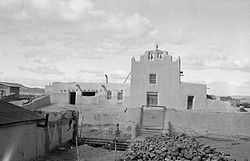Pueblo of Laguna
|
Laguna Pueblo
|
|

Laguna Mission
|
|
| Nearest city | Albuquerque, New Mexico |
|---|---|
| Coordinates | 35°1′8″N 107°23′04″W / 35.01889°N 107.38444°WCoordinates: 35°1′8″N 107°23′04″W / 35.01889°N 107.38444°W |
| Area | 108 acres (44 ha) |
| Built | 1699 |
| Architectural style | Pueblo |
| NRHP reference # | 73001154 |
| NMSRCP # | 228 |
| Significant dates | |
| Added to NRHP | June 19, 1973 |
| Designated NMSRCP | December 30, 1971 |

Pueblo of Laguna symbol
|
|
| Total population | |
|---|---|
| 6,758 (2010) | |
| Regions with significant populations | |
|
|
|
| Languages | |
| Keresan language, English language | |
| Religion | |
| traditional tribal religion, Christianity (Roman Catholicism and other) | |
| Related ethnic groups | |
|
Acoma Pueblo, other Keres people (Cochiti Pueblo, San Felipe Pueblo, Santo Domingo Pueblo, and Zia Pueblo) |
The Laguna Pueblo (Western Keres: Kawaika [kʰɑwɑjkʰɑ]) is a federally recognized tribe of Native American Pueblo people in west-central New Mexico, USA. The name, Laguna, is Spanish (meaning "small lake") and derives from the lake located on their reservation. Originally, this body of water was the only lake in what is now the state of New Mexico, and was formed by an ancient dam that was constructed by the Laguna people. After the Pueblo Revolt of 1680-1696, the Mission San José de la Laguna was erected by the Spanish at the old pueblo (now Old Laguna), and finished around July 4, 1699.
Their reservation lies in parts of four counties: In descending order of included land area they are Cibola, Sandoval, Valencia and Bernalillo Counties. It includes the six villages of Encinal, Laguna, Mesita, Paguate, Paraje and Seama. The reservation is 45 miles (72 km) west of the city of Albuquerque. The reservation consists of approximately 500,000 acres (2,000 km2).
The Laguna Pueblo (and the Acoma Pueblo) lie in the river basin of the Rio San Jose. The laguna or lake was historically much larger than the present time and hosted waterfowl of many kinds, including ducks, geese and swans. The Rio San Jose flows into the Rio Puerco near the southeast corner of the Laguna Reservation.
Laguna Pueblo, 1879
Door to Baptistry, Laguna Mission, 1934
...
Wikipedia


